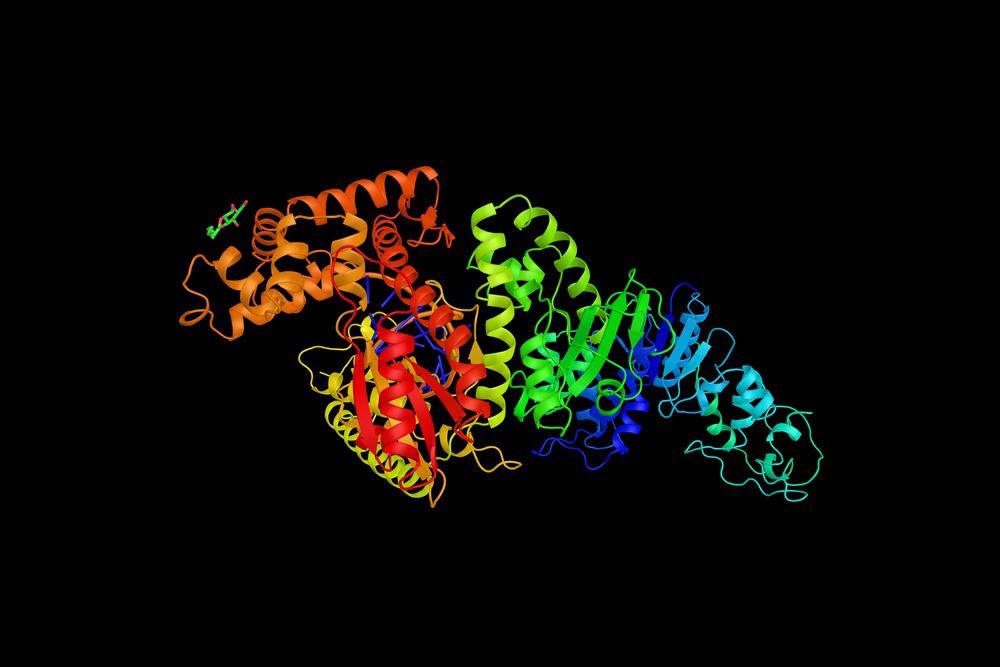Taq polymerase is the heat-stable (thermostable) DNA polymerase extracted from the thermophilic bacteria Thermus aquaticus. Its predominant function is in the polymerase chain reaction (PCR) technique, where it automates the repetitive step of amplifying specific DNA sequences. The polymerase chain reaction can multiply DNA molecules by up to a billion-fold. This produces large quantities of specific genes with downstream use across multiple applications.

Image Credit: ibreakstock/Shutterstock.com
Taq DNA polymerase has been included in a Family of DNA polymerases known as Family A. PCR utilizes DNA polymerases from both (exclusively) either Family A and Family B DNA polymerases. The Family DNA polymerases include Tth and Tma DNA polymerase alongside Taq and have 5′-3′ exonuclease activity, but normally lack 3′-5′. In the absence of the 3′-5′ exonuclease activity, the Family A polymerases are prone to error when incorporating base pairs.
Conversely, Family B DNA polymerases are high fidelity (or proofreading). This Family includes Pfu, Kod, and Tli. They possess intrinsic 3′-5′ exonuclease activity but lack 5′-3′ exonuclease activity. This enables the removal of misincorporated nucleotides during DNA synthesis, which increases their accuracy relative to the Family A polymerases.
PCR Amplification in a Nutshell
The steps involved in the PCR technique include the incubation of DNA with an excess of primer specific to the selected genomic sequence. The DNA polymerase is responsible for extending the primers using the target strands as templates.
- Denaturation (94°C): Following incubation, the PCR Mixture is heated to separate the DNA strands
- Annealing (55-65°C): This enables the primers to hybridize with the complementary regions of the newly amplified DNA.
- The extension (72°C): Taq polymerase-mediated enzymatic replication of primer-bound sequences. This occurs at a rate of ~60 bases per second at 70°C
The process is repeated several times to increase the copy number. The use of a thermophilic DNA polymerase such as Taq polymerase prevents the denaturation of the enzyme during the heating step that is necessary to separate the newly synthesized strand – this subsequently simplifies the PCR technique and increases its efficiency.
The Enzyme Kinetics of Taq Polymerase
Taq polymerase demonstrates substantial enzymatic activity at 37°C. However, it operates optimally at a much higher temperature (~72°C). Nucleotides are incorporated at a rate of two to four kilobases per minute.
However, functioning at this temperature allows for nonspecific amplification that is associated with mispriming events that occur during the initial phase of the PCR reaction. The extension can occur from oligodeoxynucleotide primers that bind non-specifically to the template DNA before the first denaturation step, which occurs at 93–95°C.
Mechanisms to circumvent this include the use of a thermolabile inhibitor that blocks the activity of the Taq polymerase until it is heat-inactivated. Consequently, the Taq polymerase only becomes active after the temperature destroys the monoclonal antibody during the initial denaturation of the PCR reaction. This means of antibody-mediated inhibition of Taq polymerase allows room temperature assembly of the PCR reaction mixture. As such, nonspecific amplification about arises from mispriming events is eliminated or reduced.
Limitations of Taq Polymerase and Comparisons to B Family DNA Polymerases
Although Taq DNA polymerases are a gold standard enzyme in PCR applications, their limitations restrict their incorporation in more complex applications.
Thermostable Taq DNA polymerase, is considered as the industry standard, with suitability for a wide range of PCR applications. However, the performance of Taq is limited in more challenging applications, such as those requiring high fidelity synthesis of long (> 2 kb) amplicons, and amplification of GC-rich sequences.
Most crucially, Taq DNA polymerase lacks proofreading activity due to the lack of the 3’-5’ proofreading activity. This does result in a low misincorporation rate, estimated between one and 10,000 bases – but compromises its fidelity. Comparisons of base substitution error rates between non-proofreading and proofreading polymerases are large; 10-2 to 10-6 vs 10-6 to 10-7, respectively.
Archaeal B-type DNA polymerases, by contrast, can remove mispaired bases due to their integral 3´→5´ exonuclease activity, resulting in higher fidelity. These include Pfu DNA polymerase (from the archaea pyrococcus furiosus) which is ~4 times more stable than Taq DNA polymerase at 95°C (though exhibits limited processivity (< 20 bases) in vitro)
KOD DNA polymerase derived from Thermococcus kodakarensis is another B-type archaeal DNA polymerase that displays both 3’-5’ exonuclease (proofreading) activity. The KOD DNA polymerase's optimum temperature (75o C) and mutation frequency (3.5 x 10-3) is similar to those of Pfu DNA polymerase, but offers an ~5 times higher elongation rate (100-130 nucleotides/s); 10-15 times greater processivity; amplification of GC rich sequences and an ability to operate using crude samples.
Collectively, these characteristics reduce the length of PCR run times, which results in a ~66% drop in time relative to Taq-mediated PCR.
References:
- Amils R. (2011) Taq Polymerase. In: Gargaud M. et al. (eds) Encyclopedia of Astrobiology. Springer, Berlin, Heidelberg. https://doi.org/10.1007/978-3-642-11274-4_1561.
- Sun S, Guo W, Yang JS, et al. (2018) TT(N)mGCCTC inhibits archaeal family B DNA polymerases. Sci Rep. doi: 10.1038/s41598-018-20127-4.
- Ishino S, Ishino Y. (2014) DNA polymerases as useful reagents for biotechnology - the history of developmental research in the field. Front Microbiol. doi:10.3389/fmicb.2014.00465.
- Eom SH, Wang J, Steitz TA. (1996) Structure of Taq polymerase with DNA at the polymerase active site. Nature. doi:10.1038/382278a0.
Further Reading
Last Updated: Jan 24, 2022